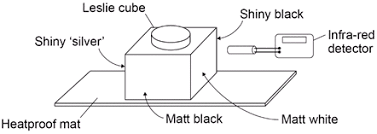
Infrared Radiation and Temperature
Every object absorbs and emits infrared radiation
All objects are continually emitting and absorbing infrared radiation. Infrared radiation is emitted from the surface of an object
The hotter an object is, the more infrared radiation it radiates in a given time
An object that;s hotter than its surroundings emits more IR radiation than it absorbs as it cools down. And an object that’s cooler than its surrounding absorbs more IR radiation than it emits as it warms up
Objects at a constant temperature emit infrared radiation at the same rate that they are absorbing it
Some colours and surface absorb and emit radiation better than others. For example, a black surface is better at absorbing and emitting radiation than a white one, and a matt surface is better at absorbing and emitting radiation than a shiny one
You can investigate emission with a leslie cube
A leslie cube is a hollow, watertight, metal cube made of e.g. aluminium, whose four vertical faces have different surfaces. You can use them to investigate IR emission by different surfaces:
Place ab empty Leslie cube on a heat-proof mat
Boil water in a kettle and fill the Leslie cube with boiling water
Wait a while for the cube to warm up, then hold a thermometer against each of the four vertical faces of the cube. You should find that all four faces are the same temperature
Hold an infrared detector a set distance away from one of the cube’s vertical faces, and record the amount of IR radiation it detects
Repeat this measurement for each of the cub’s vertical faces. Make sure you position the detector at the same distance from the cube each time
You should find that you detect more infrared radiation from the black surface than the white one, and more from the matt surfaces than the shiny ones
As always, you should do the experiment more than once, to make sure your results are repeatable
It’s important to be careful when you’re doing this experiment. Don’t try to move the cube when it’s full of boiling water-you might burn your hands. And be careful if you’re carrying a full kettle.

Infrared Radiation and Temperature
Every object absorbs and emits infrared radiation
All objects are continually emitting and absorbing infrared radiation. Infrared radiation is emitted from the surface of an object
The hotter an object is, the more infrared radiation it radiates in a given time
An object that;s hotter than its surroundings emits more IR radiation than it absorbs as it cools down. And an object that’s cooler than its surrounding absorbs more IR radiation than it emits as it warms up
Objects at a constant temperature emit infrared radiation at the same rate that they are absorbing it
Some colours and surface absorb and emit radiation better than others. For example, a black surface is better at absorbing and emitting radiation than a white one, and a matt surface is better at absorbing and emitting radiation than a shiny one
You can investigate emission with a leslie cube
A leslie cube is a hollow, watertight, metal cube made of e.g. aluminium, whose four vertical faces have different surfaces. You can use them to investigate IR emission by different surfaces:
Place ab empty Leslie cube on a heat-proof mat
Boil water in a kettle and fill the Leslie cube with boiling water
Wait a while for the cube to warm up, then hold a thermometer against each of the four vertical faces of the cube. You should find that all four faces are the same temperature
Hold an infrared detector a set distance away from one of the cube’s vertical faces, and record the amount of IR radiation it detects
Repeat this measurement for each of the cub’s vertical faces. Make sure you position the detector at the same distance from the cube each time
You should find that you detect more infrared radiation from the black surface than the white one, and more from the matt surfaces than the shiny ones
As always, you should do the experiment more than once, to make sure your results are repeatable
It’s important to be careful when you’re doing this experiment. Don’t try to move the cube when it’s full of boiling water-you might burn your hands. And be careful if you’re carrying a full kettle.

 Knowt
Knowt
